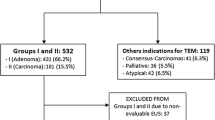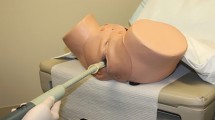Abstract
Background
Aim of the study was to assess adequacy of Colorectal Surgical Society of Australia and New Zealand (CSSANZ) endorectal ultrasound (ERUS) training and whether a subsequent learning curve exists.
Methods
A prospective audit of ERUS for staging rectal cancer by a single surgeon from commencement of consultant practice was performed. Data were recorded in a prospectively maintained database. The audit commenced on completion of CSSANZ training. T- and N-stage were assessed clinically, then by ERUS prior to treatment and finally by histology over 8 years.
Results
The results were compared over three time periods: the first a single year, then two three-year periods. Two hundred and seventy-two patients were examined. Two hundred and thirty-three were assessable for T-stage (13 no tumour excision, 26 long course pre-operative radiotherapy) and 142 for N-stage (74 endoanal excision, 17 proximal mesorectum un-assessable). Overall accuracy was 82% for T-stage and 73% for N-stage. Accuracy for T- and N-staging did not change significantly over the three time periods (T: 82.1, 82.3, 81.6%, P = 0.14; N: 83.3, 67.9, 74.2%, P = 0.31). The utility of ERUS was demonstrated by clinical assessment not being possible in 32% of cases and where the two modalities disagreed was correct 82% of the time.
Conclusions
Endorectal ultrasound rectal cancer staging is accurate for T-stage. Competency in ERUS can be achieved in the CSSANZ fellowship and accuracy does not improve with further experience. An ERUS accreditation scheme should be established for future trainees.

Similar content being viewed by others
References
Australian Institute of Health and Welfare (2006) Chronic diseases mortality in Australia. Available at: www.aihw.gov.au/cdarf/data_pages/mortality/index.cfm
Ridgway PF, Darzi AW (2003) The role of total mesorectal excision in the management of rectal cancer. Cancer Control 10:205–211
O’Connell JB, Maggard MA, Ko CY (2004) Colon cancer survival rates with the new American joint committee on cancer sixth edition staging. J Natl Cancer Inst 96:1420–1425
Wong RK, Tandan V, De Silva S et al. (2008) Pre-operative radiotherapy and curative surgery for the management of localised rectal carcinoma. The Cochrane Library: Issue 3
Birgisson H, Påhlman L, Gunnarsson U et al (2008) Late gastrointestinal disorders after rectal cancer surgery with and without preoperative radiation therapy. Br J Surg 95:206–213
Marijnen CA, van de Velde CJ, Putter H et al (2005) Impact of short-term preoperative radiotherapy on health-related quality of life and sexual functioning in primary rectal cancer: report of a multicenter randomized trial. J Clin Oncol 23:1847–1858
Peeters KC, van de Velde CJ, Leer JW et al (2005) Late side-effects of short course pre-operative radiotherapy combined with total mesorectal excision for rectal cancer: increased bowel dysfunction in irradiated patients—a Dutch colorectal cancer group study. J Clin Oncol 23:6199–6206
Tytherleigh MG, Warren BF, McC Mortensen NJ (2008) Management of early rectal cancer. Br J Surg 95:409–423
Puli SR, Bechtold ML, Reddy JB et al (2010) Can endoscopic ultrasound predict early rectal cancers that can be resected endoscopically? A meta-analysis and systematic review. Dig Dis Sci 55:1221–1229
Puli SR, Bechtold ML, Reddy JB et al (2009) How good is endoscopic ultrasound in differentiating various T stages of rectal cancer? Meta-analysis and systematic review. Ann Surg Oncol 16:254–265
Zhao DB, Wu YK, Shao YF et al (2009) Prognostic factors for 5-year survival after local excision of rectal cancer. World J Gastroenterol 15:1242–1245
Hase K, Shatney CH, Mochizuki H et al (1995) Long-term results of curative resection of “minimally invasive” colorectal cancer. Dis Colon Rectum 38:19–26
Rothenberger DA, Garcia-Aguila J (2000) Role of local excision in the treatment of rectal cancer. Semin Surg Oncol 19:367–375
Bipat S, Glas AS, Slors FJM et al (2004) Rectal cancer: local staging and assessment of lymph node involvement with endoluminal US, CT, and MR imaging—a meta-analysis. Radiology 232:773–783
Milsom JW, Czyrko C, Hull TL et al (1994) Preoperative biopsy of pararectal lymph nodes in rectal cancer using endoluminal ultrasnography. Dis Colon Rectum 37:364–368
Puli SR, Reddy JB, Bechtold ML et al (2009) Accuracy of endoscopic ultrasound to diagnose nodal invasion by rectal cancers: a meta-analysis and systematic review. Ann Surg Oncol 16:1255–1265
Hildenbrandt U, Feifel G (1985) Preoperative staging of rectal cancer by intrarectal ultrasound. Dis Colon Rectum 28:42–46
Kim E, Hwang JM, Garcia-Aguilar J (2008) Local excision for rectal carcinoma. Clini Colorectal Cancer 7:376–385
Onaitis MW, Noone RB, Hartwig M et al (2001) Neoadjuvant chemoradiation for rectal cancer: analysis of clinical outcome from a 13 year institutional experience. Ann Surg 6:778–785
Marjnen CAM, Nagtegaal ID, Kranenbarg EK et al (2001) No downstaging after shot-term preoperative radiotherapy in rectal cancer patients. J Clin Oncol 19:1976–1984
Minitab Pty Ltd, Sydney, Australia
Rifkin MD, Ehrlich SM, Marks G (1989) Staging of rectal carcinoma: prospective comparison of endorectal US and CT. Radiology 170:319–322
Saitoh N, Okui K, Sarashina H et al (1986) Evaluation of endosonographic diagnosis of rectal cancer. Dis Colon Rectum 29:234–242
Bali C, Nousias V, Fatouros M et al (2004) Assessment of local stage in rectal cancer using endorectal ultrasonography (EUS). Tech Coloproctol 8:S170–S173
Orrom WJ, Wong WD, Rothenberger DA et al (1990) Endorectal ultrasound in the preoperative staging of rectal tumours. Dis Colon Rectum 33:654–659
Adams DR, Blatchford GJ, Lin KM et al (1999) Use of preoperative ultrasound staging for treatment of rectal cancer. Dis Colon Rectum 42:159–166
Akasu T, Sugihara K, Moriya Y et al (2000) Endorectal ultrasound and treatment of early rectal cancer. World J Surg 24:1061–1068
Zbar AP (2006) Endorectal ultrasonography in rectal cancer: a preliminary Barbadian experience. West Indian Med J 55:313–318
Vanagunas A, Lin DE, Stryker SJ (2004) Accuracy of endoscopic ultrasound for restaging rectal cancer following neoadjuvant chemoradiation therapy. Am J Gastroenterol 99:109–112
Bianchi P, Ceriani C, Palmisano A et al (2006) A prospective comparison of endorectal ultrasound and pelvic magnetic resonance in the preoperative staging of rectal cancer. Ann Ital Chir 77:41–46
Boyce GA, Sivak MV Jr, Lavery IC et al (1992) Endoscopic ultrasound in the pre-operative staging of rectal cancer. Gastrointest Endosc 38:468–471
Giovannini M, Bories E, Pesenti C, Moutardier V, Lelong B, Delpéro JR (2006) Three- dimensional endorectal ultrasound using a new freehand software program: results in 35 patients with rectal cancer. Endoscopy 38:339–343
Glaser F, Kuntz C, Schlag P et al (1993) Endorectal ultrasound for control of preoperative radiotherapy of rectal cancer. Ann Surg 217:64–71
Gualdi GF, Casciani E, Guadalaxara A et al (2000) Local staging of rectal cancer with transrectal ultrasound and endorectal magnetic resonance imaging: comparison with histologic findings. Dis Colon Rectum 43:338–345
Herzong U, von Flue M, Tondelli P et al (1993) How accurate is endorectal ultrasound in the preoperative staging of rectal cancer? Dis Colon Rectum 36:127–134
Hsieh PS, Changchien CR, Chen JS et al (2003) Comparing results of preoperative staging of rectal tumour using endrectal ultrasonography and histopathology. Chang Gung Med J 26:474–478
Kaneko K, Boku N, Hosokawa K et al (1996) Diagnostic utility of endoscopic ultrasonography for preoperative rectal cancer staging estimation. Jpn J Clin Oncol 26:30–35
Kim JC, Kim HC, Yu CS et al (2006) Efficacy of 3-dimensional endorectal ultrasonography compared with conventional ultrasonography and computed tomography in preoperative rectal cancer staging. Am J Surg 192:89–97
Mackay SG, Pager CK, Joseph D et al (2003) Assessment of the accuracy of transrectal ultrasonography in anorectal neoplasia. Br J Surg 90:346–350
Maor Y, Nadler M, Barshack I et al (2006) Endoscopic ultrasound staging of rectal cancer: diagnostic value before and after chemoradiation. J Gastroenterol Hepatol 21:454–458
Massari M, De Simone M, Cioffi U et al (1998) Value and limits of endorectal ultrasonography for preoperative staging of rectal carcinoma. Surg Laparosc Endosc 8:438–444
Meyenberger C, Huch Boni RA, Bertschinger P et al (1995) Endoscopic ultrasound and endorectal magnetic resonance imaging: a prospective, comparative study for preoperative staging and follow-up of rectal cancer. Endoscopy 27:469–479
Nielsen MB, Qvitzau S, Pedersen JF et al (1996) Endosonography for preoperative staging of rectal tumours. Acta Radiol 37:799–803
Pappalardo G, Reggio D, Frattoroli FM et al (1990) The value of endoluminal ultrasonography and computed tomography in the staging of rectal cancer: a preliminary study. J Surg Oncol 43:219–222
Norton SA, Thomas MG (1999) Staging of rectosigmoid neoplasia with colonoscopic endoluminal ultrasonography. Br J Surg 86:942–946
Sailer M, Leppert R, Kraemer M et al (1997) The value of endorectal ultrasound in the assessment of adenomas, T1- and T2-carcinomas. Int J Colorectal Dis 12:214–219
Shami VM, Parmar KS, Waxman I (2004) Clinical impact of endoscopic ultrasound and endoscopic ultrasound-guided fine-needle aspiration in the management of rectal carcinomas. Dis Colon Rectum 47:59–65
Spinelli P, Schiavo M, Meroni E et al (1999) Results of EUS in detecting perirectal lymph node metastases of rectal cancer: a pathologist makes the difference. Gastrointest Endosc 49:754–758
Thaler W, Watzka S, Martin F et al (1994) Preoperative staging of rectal cancer by endoluminal ultrasound vs magnetic resonance imaging. Preliminary results of a prospective, comparative study. Dis Colon Rectum 37:1189–1193
Garcia-Aquilar J, Pollak J, Lee SH et al (2002) Accuracy of endorectal ultrasonography in preoperative staging of rectal tumours. Dis Colon Rectum 45:10–15
Manger T, Stroh C (2004) Accuracy of endorectal ultrasonography in the preoperative staging of rectal cancer. Tech Coloproctol 8:S14–S15
Kim JC, Yu CS, Jung HY et al (2001) Source of errors in the evaluation of early rectal cancer by endoluminal ultrasonography. Dis Colon Rectum 44:1302–1309
Osti MF, Padovan FS, Pirolli C et al (1997) Comparison between transrectal ultrasonography and computed tomography with rectal inflation of gas in preoperative staging of lower rectal cancer. Eur Radiol 7:26–30
Caseiro-Alves F, Goncalo M, Cruz L et al (1998) Water enema computed tomography (WE-CT) in the local staging of low rectal neoplasms: comparison with transrectal ultrasound. Abdom Imag 23:370–374
Nishimori H, Sasaki K, Hirata K, Natori H (1998) The value of endoscopic ultrasonography in preoperative evaluation of rectal cancer. Int Surg 83:157–160
Marone P, Petrulio F, de Bellis M et al (2000) Role of endoscopic ultrasonography in the staging of rectal cancer: a retrospective study of 63 patients. J Clin Gastroenterol 30:420–424
Feifel G, Hildebrandt U, Dhom G (1987) Assessment of depth of invasion in rectal cancer by endosonography. Endoscopy 19:64–67
Marusch F, Koch A, Schmidt U et al (2002) Routine use of transrectal ultrasound in rectal carcinoma: results of a prospective multicentre study. Endoscopy 34:385–390
Waizer A, Powsner E, Russo I et al (1991) Prospective comparative study of magnetic resonance imaging versus transrectal ultrasound for preoperative staging and follow-up of rectal cancer. Preliminary report. Dis Colon Rectum 34:1068–1072
Sentovich SM, Blatchford GJ, Falk PM et al (1993) Transrectal ultrasound of rectal tumours. Am J Surg 166:638–641
Starck M, Bohe M, Simanaitis M et al (2003) Rectal ultrasonography can distinguish benign rectal lesions from invasive early rectal cancers. Colorectal Dis 5:246–250
Kotanagi H, Yoshioka T, Muto O et al (1997) Macroscopic assessment of nodal metastasis is not reliable in colon cancer. Int J Clin Oncol 2:133–137
Fleming FJ, Hayanga AJ, Glynn F et al (2007) Incidence and prognostic influence of lymph node micrometastasis in rectal cancer. Eur J Surg Oncol 33:998–1002
Badger SA, Devlin PB, Neilly PJD et al (2007) Preoperative staging of rectal carcinoma by endorectal ultrasound: is there a learning curve? Int J Colorectal Dis 22:1261–1268
Carmody BJ, Otchy DP (2000) Learning curve of transrectal ultrasound. Dis Colon Rectum 43:193–197
Conjoint Committee for Recognition of Training in Gastrointestinal Endoscopy. Information for Supervisors: Changes in Endoscopic Training. Available at: http://conjoint.gesa.org.au/
American Society for Gastrointestinal Endoscopy (1998) Guidelines for credentialing and granting privileges for gastrointestinal endoscopy. Gastrointest Endosc 48:679–682
Acknowledgments
The authors would like to thank Dr Peter Stewart, Dr Anthony Eyers and Dr Michael Solomon for their collective input throughout training.
Author information
Authors and Affiliations
Corresponding author
Rights and permissions
About this article
Cite this article
Morris, O.J., Draganic, B. & Smith, S. Does a learning curve exist in endorectal two-dimensional ultrasound accuracy?. Tech Coloproctol 15, 301–311 (2011). https://doi.org/10.1007/s10151-011-0711-7
Received:
Accepted:
Published:
Issue Date:
DOI: https://doi.org/10.1007/s10151-011-0711-7




